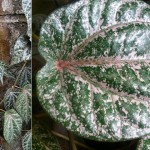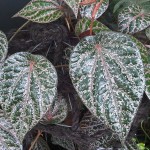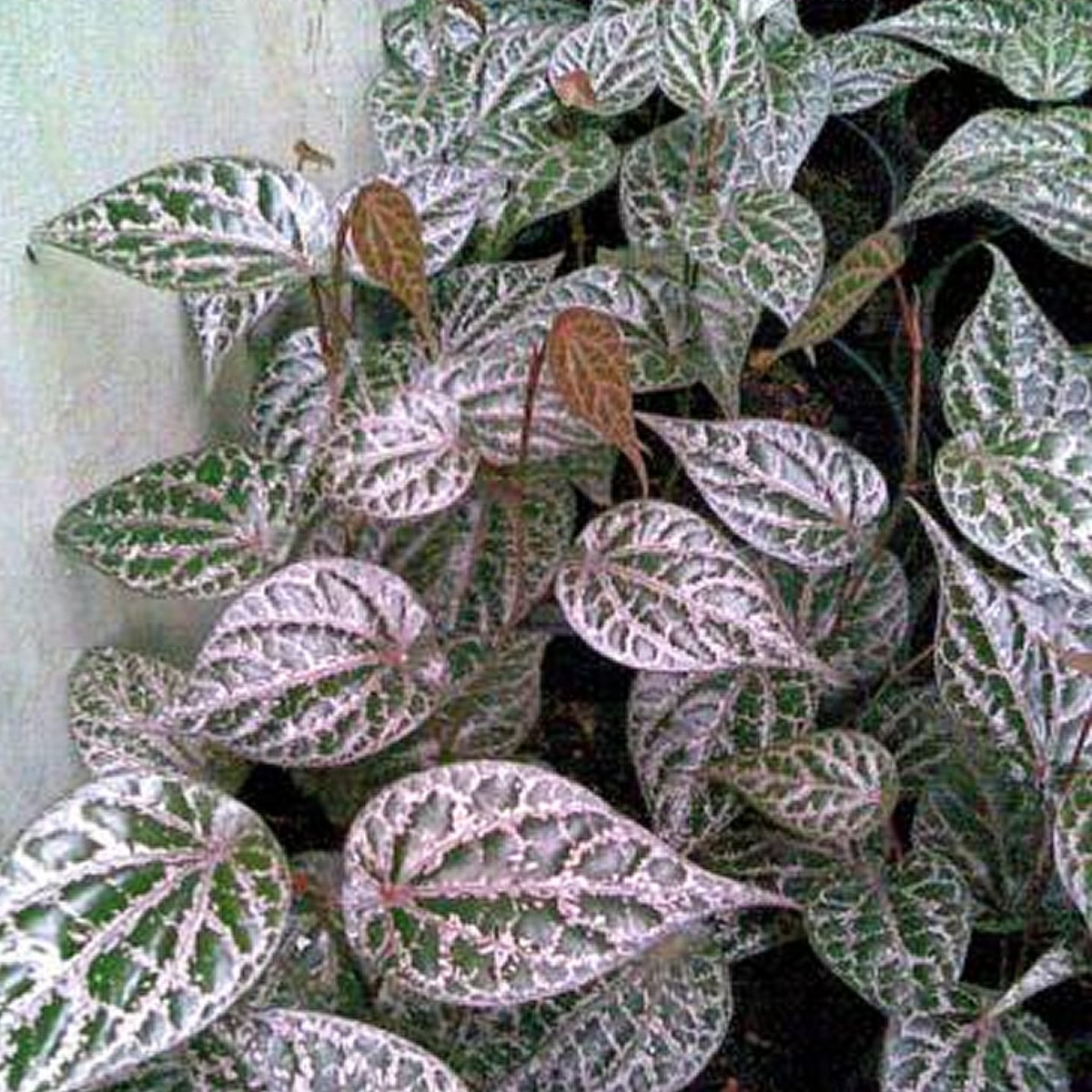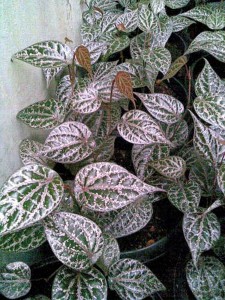Family: Piperaceae
Synonymous: Piper ornatum
Steffensia crocata
Distribution ad habitat: Piper crocatum is a vine endemic to Peru, South of America, most commonly found in the understory of lowland tropical rainforests, but can also occur in clearings and in higher elevation life zones.
Description: Piper crocatum is a climbing or tailing vine that is prized for its colourful leaves that makes it an exotic indoor plant.
Piper crocatum has slender stems bearing pointed, heart-shaped leaves up to 13cm (5 inch) long and 10cm (4 inch) wide. The leaves have reddish, 2cm (0.8 inch) long leaf-stalks, which are attached not at the end of the leaf, but slightly toward the middle. Leaf surface are puckered. The upper surface is olive green heavily spotted with pinkish silver markings. The pink tinge is almost pronounced wherever a marking occurs near main veins. Leaves undersides are unmarked deep maroon. The plant does not normally produce flowers when is grown indoors.
Piper crocatumis a rare species that is seldom commercially available and it is sought-out by many plant collectors.
Proper care: Piper crocatum plant is a somewhat demanding plant, steady environmental conditions being essential for its health and development. It is particularly suitable for growing in a large terrarium or special plant window. They are vining in habit and can be supported to climb upon-like a tree trunk or a moss stick or grown in hanging baskets. Prune these plants only to maintain form and control size. Piper crocatum is a sturdy plant yet slow growing.
Light: Grow these plants in direct filtered sunlight (a translucent blind or curtain is a useful filter). An east or west window is the best place for growing this plant.
Temperature: Piper crocatum must have warmth - a minimum of 15C (59F) - or they will shed most of their leaves. They do not flourish if subjected to fluctuating temperatures and dry air. Keep the temperatures as constant as possible and increase the humidity by standing pots on shallow trays of moist pebbles. Mist-spray the foliage once a week.
Watering: Throughout the year water moderately, enough to make the potting mixture moist throughout, but allowing the top couple of centimetres (0.8 inch) of the potting mixture to dry out before watering again.
Feeding: Except in midwinter, feed plants every two weeks with standard liquid fertiliser. Piper crocatum do not have a distinct rest period, but they grow less actively in winter.
Potting and repotting: Use a soil based potting mixture. Piper crocatum have fairly small root systems and should not be planted in needlessly big containers. A 13-15cm (5-6 inch) pot should be the biggest needed for an ordinary potted specimen. Move a plant into a pot size larger only when it has made so much top growth that there is an obvious imbalance between top growth and pot size - a relatively dependable indication of the need for more root space. Repotting may be done at any time, as long as the plants are actively growing. For the best effect in a hanging baskets in a 20cm (8 inch) basket and replace them with fresh specimens every second year.
Propagation: Propagate Piper crocatum in late spring or early summer by stem cutting 8-10cm (3-4 inch) long. Trim each cutting just bellow a leaf, remove the bottom leaf, dip the cut end of the stem in hormone rooting power and plant it in a 5 or 8cm (2-3 inch) pot of moistened equal-parts mixture of peat moss and coarse sand. Do not substitute perlite for sand as perlite retain too much moisture for these plants. Place the cutting in a plastic bag or heated propagation case and stand it in bright filtered light at a temperature of about 23C (73F). When renewed top growth shows that rooting has occurred - normally in four to six weeks - uncover the rooted cutting gradually over a course of about two weeks. The objective of this procedure is to acclimatise the new plant to the less humid air outside the bag or propagator case.
Water very sparingly until the plant has made some further growth. It is probably best to wait for 10 or 12 weeks after the start of propagation before beginning to feed the plant with fertiliser. When roots have completely filled the pot, as indicated by 5 or 8cm (2-3 inch) of top growth, move the young plant to a slightly larger pot of soil based potting mixture and begin to treat it as a mature Piper crocatum plant. At this point, instead of repotting the plant singly, it can of course be planted with others in a hanging basket.
Problems: No known problems with insects. Piper crocatum plants are susceptible to root diseases.
Treatment: It is important to maintain warm temperatures and accurate watering to circumvent this problem.
Like most pipers, Piper crocatum form exudates or small beads on the backsides of the leaves and stems. In time, there appear tiny black dots. This is normal physiology and not an insect infestation.
Use and display: Piper crocatum is often grown upright and trained around three or four thin stakes, but it also makes an attractive display when the shoots are permitted to trail down from a hanging basket.
A spectacular tropical vine terrifically suited for the terrarium.
SUMMARY:
CHARACTERISTICS:
Foliage coloured
Shape climbing and trailing
Height: 90-120 cm (36-48 inch)
PROPER CARE:
Watering in active growth period moderately
Light bright filtered
Temperature in active growth period min 15C max 24C (59-75F)
Humidity high
Hardiness zone: 11






